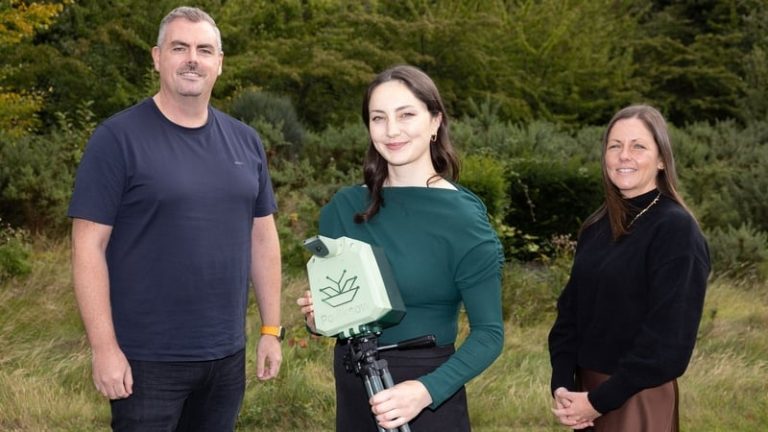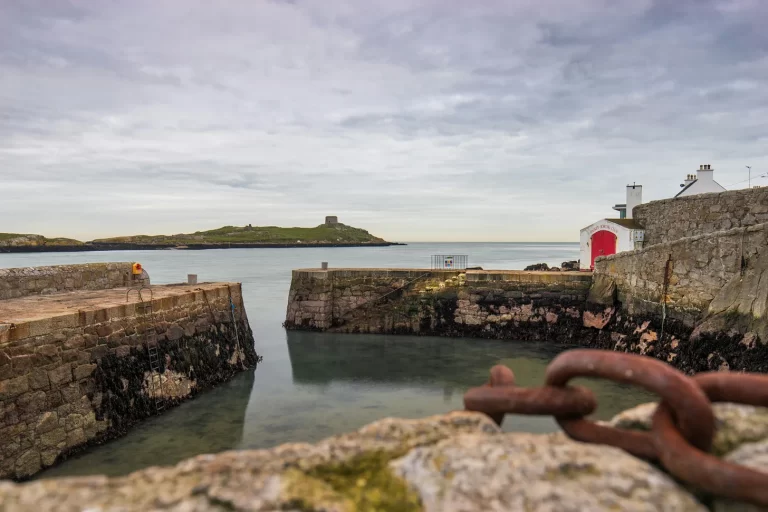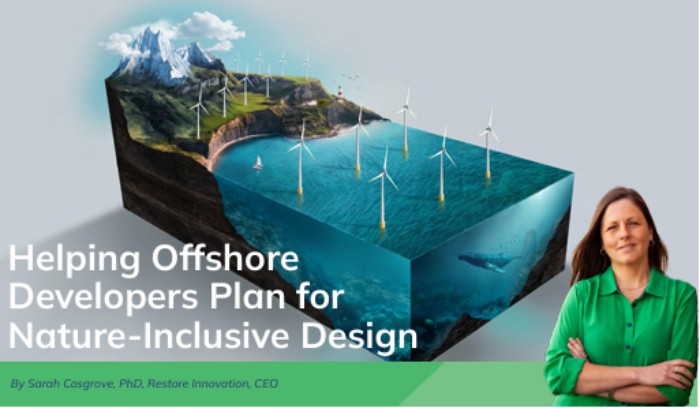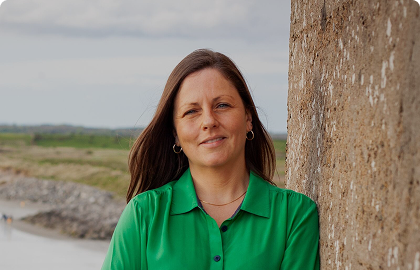In the rapidly shifting offshore energy sector, innovation is no longer just about efficiency and economics.
Increasingly, biodiversity and ecological stewardship are shaping how projects are designed and delivered. This is the space where Restore Blue, a young Irish company founded by marine ecologist Dr Sarah Cosgrove, has made its mark. The company has developed a pioneering software platform designed to support offshore developers in embedding nature inclusive design (NID) into their projects, ensuring both compliance with tightening regulations and meaningful contributions to ocean health.
For Cosgrove, Restore Blue was born from a professional journey that bridged academic research and consultancy. “I worked in universities in Ireland and the USA, between research and working positions, for around 15 years on marine ecology projects,” she tells Energy Focus. Her career took her to Texas in 2016, where she investigated the ecological aftermath of the Deepwater Horizon oil spill. “That highlighted to me that we do not have the perfect remediation or restoration measures in place for these disasters, and it highlighted the impact the fossil fuel industry can have on our marine ecosystems. I became more interested in the renewable energy sector and I returned to Ireland five years later to work in an offshore planning consultancy.”
It was in this consultancy environment that Cosgrove noticed a significant gap. “During that time, working directly with developers, I realised there was very little support for marine restoration. There was a lot of really innovative technology coming out to promote NID at offshore sites, but developers were not aware of what options were available and what ecological benefits could be brought to their specific site.”
Cosgrove saw the need for a centralised system that could demystify this new but vital field, reducing uncertainty while enabling developers to make confident, evidence-based choices. “That is when I conceptualised Restore. I wanted to bring my world of working in marine ecology together with knowledge of the offshore industry to develop a software solution that allows instant access to all the information that is out there on a global scale related to nature inclusive design.”
NATURE INCLUSIVE DESIGN
At the heart of Restore Blue is a powerful data-driven tool. Before founding the company, Cosgrove had been building a comprehensive database of NID-related technologies, from biodiversity protection to monitoring solutions. “We now have the most comprehensive global data set out there, and we have data share agreements with those that develop and supply nature tech. They feed directly into our backend system keeping things as up to date as possible.”
The software, now in its first iteration, enables developers to explore a tailored set of options for embedding biodiversity enhancement and protection strategies into their offshore projects. “It’s about facilitating more effective decision making and giving access to as much information as possible around nature inclusive technologies. The user journey when working with the software includes the input of some high-level criteria related to their project type – water depth substrate type, type of infrastructure, project stage, geography etc. Our system then runs a model for best fit in terms of NID based on the needs of the project.”
Far from simply providing a list, the system generates detailed outputs. “Our system offers a range of nature inclusive options and exports a report with extensive information on each solution, including case studies of how and where they have worked in the past. It also gives a direct link to suppliers of those technologies. We don’t produce a project plan for NID. Instead, we match the best technology to a site.”
INTELLIGENT DECISIONS
In addition to its own data, Restore Blue is advancing its software with powerful integrations. “We are now on a two-year programme (ESA-BIC) supported by the European Space Agency and Enterprise Ireland to use satellite data to help inform decisions further. That means, we can look at an individual site and feed in data layers around local species, physio chemical properties, net primary productivity etc and that will help to advance our model to result in more effective decision making.”
Artificial intelligence will become another cornerstone of the platform. “We have an AI integration in our platform where every piece of legislation related to NID, and offshore planning is fed into our system. Alongside just matching technology to a site, we use the power of that additional information to help align our solutions with legislation, policy, and regulation. It’s a more intelligent search than what could be done by someone sitting for a long period of time, with a more robust output.”
This matters because regulatory landscapes differ not just between regions but often between neighbouring countries and industries. “There are some umbrella policies, but for example, each EU member state has their own evaluation process for auctions. From 2026, under the EU Net-Zero Industry Act at least 30% of the scoring that must be allocated to non-price criteria including sustainability, biodiversity and environmental stewardship. Each state decides how to distribute this weighting and what the specific focus will be. In addition, the EU Nature Restoration Law requires each Member State to prepare its own national restoration plan. Alongside this, countries also have their own marine spatial plans and objectives. The result is a complex and fragmented policy landscape that can be challenging to navigate.
COLLABORATION AND SCALE
Restore Blue’s model is collaborative by design, working hand-in-hand with technology suppliers and developers. “Our relationships with tech suppliers have been built over the last two years through direct engagement. We don’t want to be a company that gleans info from various sources and gives a dump of knowledge to clients. The power we have is the relationships we have built and the trust we have with suppliers.”
The benefits for developers are equally clear. “The bigger players have strong internal biodiversity teams but what we offer takes away a huge manual research effort. Their biodiversity team would have to dig very deep to find what we provide to them instantly. We enable biodiversity teams to do their work more efficiently and have instant information at their fingertips.”
Cosgrove and team are now moving from concept to delivery, with their first pilots underway. “We have been building the platform for the last 12 months and we are ready to pilot alongside some international offshore developers and marine consultancies. That will help us dictate our next stage of development because NID is still a niche area for a lot of people and we want to ensure we continue to offer differentiating value to the industry.”
While offshore wind is the company’s immediate focus, the platform’s flexibility allows wider application. “What we have developed is very much scalable and adaptable for any offshore project. We are starting to explore and engage with marina, port expansion, and offshore aquaculture projects. It is not sector specific and there is no geographical limitation to what we are providing.”
ROBUST TECHNICAL ROADMAP
With a dynamic and specialised team, Restore Blue has ambitions that match the global scale of the renewable energy challenge. Backed by private and state investment, supported by the European Space Agency, and guided by a strong board, the business has quickly established itself as a trusted partner for offshore developers. Its early traction demonstrates both confidence in its model and recognition of the value it brings to an industry under growing pressure to deliver on biodiversity commitments.
The way ahead is clearly defined. “Our technical roadmap sees us refining and optimising before Q2 2026 when we plan to pilot our spatial planning integration. In Q3 next year, we want to launch an advanced AI reporting feature that brings together key datasets across geospatial, NID technology, and relevant policy and legislation that will allow a developer to create a biodiversity strategy using our software.”
Nascent markets will also be a key opportunity. “We see emerging markets – Asia-Pacific, South America, Canada, Australia – there is a need for energy that won’t go away. It’s about allowing these projects to get through the planning phase and allowing the developers to generate revenue, giving confidence back to the industry. We’re at a critical point and a lot of countries need to start converting projects.”
For Cosgrove, the mission is as personal as it is professional. “I am passionate about renewable energy, and I remain optimistic. We need to get behind it as best we can and see the opportunities that are out there. Helping developers to see the potential for the co-existence of nature inclusive actions and energy infrastructure and take action on them is what we want. Leading a start-up is tough, but I’m certainly not unchallenged, and I certainly wouldn’t swap it.”
As global demand for renewable energy accelerates and environmental considerations become embedded in funding and permitting frameworks, Restore Blue is positioning itself at the crossroads of ecology and energy. With its first pilots concluding in 2025, they are currently fundraising to execute a clear plan for phased growth, the company stands ready to help shape an offshore energy industry that builds biodiversity into its very foundations.
Read More: https://www.energy-focus.net/restore-blue-building-biodiversity-into-offshore-energy/



